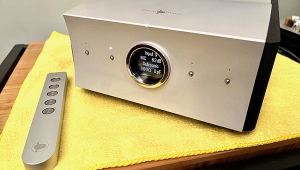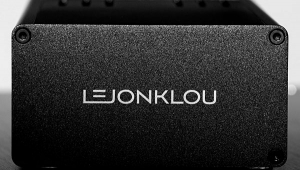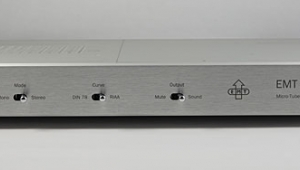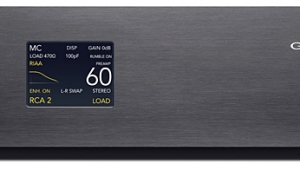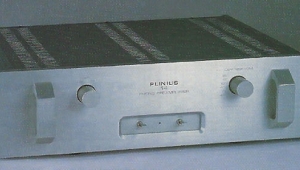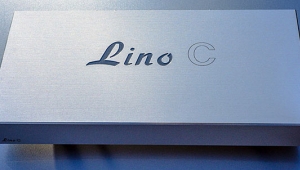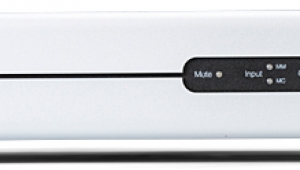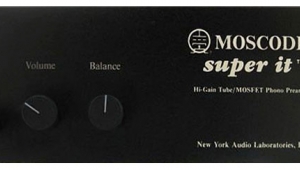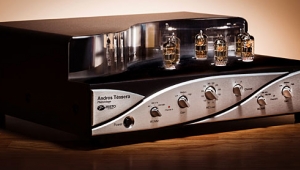| Columns Retired Columns & Blogs |
Manley Labs Steelhead phono preamplifier Page 2
Both fixed and variable outputs are tube-buffered, with low output impedance. "No wanky cathode-follower (oh so boring) outputs like the other guys," Manley's website proclaims, adding, "Okay, drive those audiophile high-capacitance cables, why doncha'?" I did.
Choose Your Sound
Because there are so many variables and you can choose them so easily, describing the specific sound of the Steelhead is almost impossible. You can, within certain limits, make it and your cartridge sound any way you like. But no matter how you vary the impedance in MC input, the resistance in MM, or capacitive loading in MM; whether you run your low-output MC via the MM or MC inputs; or whether you drive your amps directly or through your preamp (whew!), the Steelhead delivers a few sonic constants, among which are unusually low noise (regardless of gain, loading, etc.), spectacular transient speed, rhythmic certainty, clarity of musical line, breathtaking transparency, and positively astounding dynamics.
 If you own a low-output MC cartridge, your natural first choice would be to use the MC input. You then set the impedance switch to the position that best matches your cartridge's output impedance. But that's not the same as your cartridge's DC resistance, which is what some confused cartridge manufacturers list as "internal impedance." But we're all confused. The best thing you can do is set the impedance by listening.
If you own a low-output MC cartridge, your natural first choice would be to use the MC input. You then set the impedance switch to the position that best matches your cartridge's output impedance. But that's not the same as your cartridge's DC resistance, which is what some confused cartridge manufacturers list as "internal impedance." But we're all confused. The best thing you can do is set the impedance by listening.
To set capacitive loading for a MM cartridge, you first find out the load capacitance recommended by the cartridge manufacturer, then subtract your phono cable's capacitance (per unit length), which most cable manufacturers should be able to provide. If the cartridge calls for 150pF and the cable has 50pF total, you dial in 100pF.
Then you play some music, twiddle the transformer's impedance knob, and what do you find? Unlike with resistive loading, the lower you set the Manley's impedance, the louder and more energetic the sound. That's because—at least with the Helikon SL, which has a relatively low source impedance—you maximize power transfer the lower you set the autoformer's input impedance.
But be sure to try even the lowest-output MC cartridge into the MM section, as I did. With the 220µV Helikon SL, there was more than enough gain and pitch-black backgrounds. This resulted in even greater purity and delicacy, which is why Manley provides variable loading for the MM input, which normally would be fixed at 47k ohms. If your MC cartridge's manufacturer suggests running it at 47k and you're using MM mode, you can easily warm up bright recordings somewhat by experimenting with loading. In theory, if the cartridge is underdamped, it will "ring" when fed a squarewave, with visible overshoot. If it's overdamped, it will react too slowly and the wave's corners will be rounded off.
In practice, and for a variety of reasons, it's not that simple. In MC mode, you can achieve similar results by moving away from the setting that provides the best impedance match. In the end, especially with a phono preamp that permits such convenient on-the-fly adjustments, listening is the best way to fine-tune resistive loading or match impedances.
So I played and equalized away, finding the setup that sounded best to me. No matter what I did, the Steelhead never sounded lush, romantic, or warm—unless the recording did. I played a German pressing of Stevie Wonder's "You Are the Sunshine of My Life" four times, running the Helikon SL into the MM and MC inputs using the variable output, and then again into both inputs but through the fixed output into the Hovland HP-100. Each rendition sounded different. In the end, I preferred the MM input with the Steelhead driving the Hovland, even though the direct connection sounded "faster" and more pure.
Finally, I played the Wonder track through the Hovland's built-in phono section. Though the Hovland is very, very good, it couldn't compete with the Steelhead, especially in bass dynamics, transient speed, and overall clarity. But on "You Are the Sunshine of My Life," the Hovland's slightly warmer, slower, softer presentation was the more pleasing!
But with the best recordings—the ones I use as references—and driving the power amp directly, the Steelhead had unsurpassed resolution of ultra-low-level detail, sometimes dug out surprising new musical information from very familiar recordings, and gave the finest macrodynamic bass performance I've heard from vinyl, with high-frequency transients that were crisp yet delicate—as you might hear them live.
Overall, the Steelhead delivered the best vinyl playback I've heard from my system. It combined speed, frequency extension, resolution, harmonic structure, focus, air, stage depth, image specificity, and, most important, overall musical coherence in a way that made the music seem to fly from the speakers unrestrained by mechanical or electrical bounds.
Will the Steelhead be perfect for everyone? Nothing is, and I'd bet some listeners will find it lacking in midrange bloom and overall plushness. A solid-state system might require a pure-vacuum-tube phono section, such as Audio Research's Reference, to balance out the Steelhead's honest high-frequency extension and blazing speed. And, of course, bad recordings—of which there are more than we like to acknowledge—have no place to hide when confronted with so ruthlessly revealing a phono section. Then again, I've got a set of lush-sounding Amperex Bugle Boy ECC88s that might take this assault on the state of the analog art to exalted levels.
Unfortunately, the Steelhead was designed as a price-no-object component. When the financial dust had settled, Eveanna Manley found that admission was a steep $7300. But remember: If you're a turntable-only audiophile, you don't need another preamplifier, and you can use the fixed outputs as a "Record Out." Multi-sourcers will have to do what I did during the review period: I have two sets of interconnects running to the amplifier, one from the Steelhead, the other from the preamp. Will this become my permanent setup? I'm considering it.
- Log in or register to post comments
